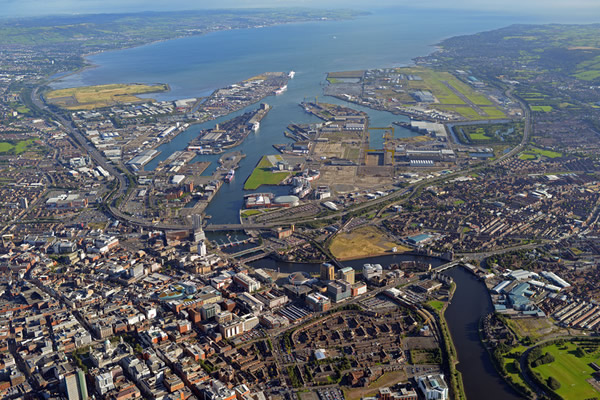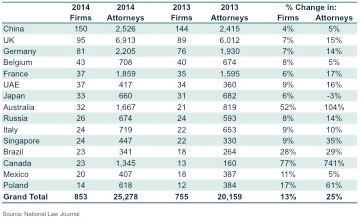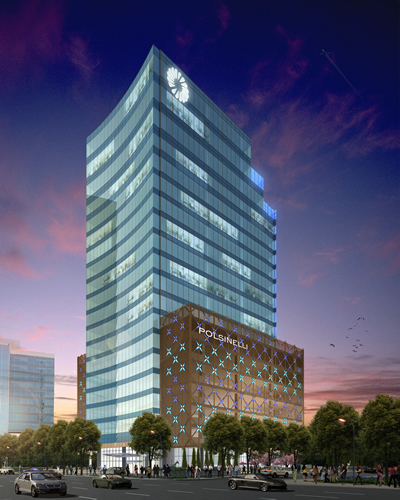“Financial services and law firms accounted for more than 41 percent of total leasing in 2014 compared to 22.9 percent for the technology sector.”
So said JLL’s 2015 Digital Skyline report, issued in June, speaking of San Francisco’s office market, where both workspace lease rates and office building purchase prices continue to soar, and where more than 50 percent of the 2.2 million sq. ft. of office space under construction is already leased.
It’s a reminder that, while the creatives and techies continue to occupy new workspace as well as trophy column space in the media, professional services organizations such as insurance, financial and law firms continue to occupy major space in buildings.
According to JLL, law firm growth, like that of many sectors, comes from wanting to be close to clients, among other factors. Case in point: “In Silicon Valley, law firms now occupy 20 percent of the office market, compared with eight percent in 2011,” JLL stated in an October 2014 report. “In Dallas, several national law firms have opened offices recently in the booming energy hub, including McGuireWoods, Holland & Knight and Schiff Hardin. While the percentage of law firms occupying the market has held steady at 14 percent since 2011, they are taking over larger blocks of space, indicating growth. Currently, 31 firms are using more than 50,000 square feet of office space, compared with 22 firms in 2011. New construction is already underway.”

That trend is evident in the activity of national firm Arent Fox, which opened a new Washington, D.C., office in early 2013 while simultaneously announcing the establishment of a new San Francisco office by the end of that year.
Site Selection’s New Plant Database, which only tallies facility projects and major leases involving at least $1 million in investment, 20 new jobs created or 20,000 new sq. ft. of space, has tallied more than 70 such qualifying investments by law firms in the United States over the past three years, led by Chicago and Houston, followed by Washington, D.C., New York and Atlanta. But it’s not just the big cities benefiting. A few snapshots:
- In Buffalo, according to Buffalo Niagara Enterprise, more than half a dozen deals have taken place over the past several years, including Jaeckle Fleischmann & Mugel leasing approximately 33,000 sq. ft. in the Avant Building, and Phillips Lytle anchoring the redeveloped former Gen. Donovan office building. Goldberg Segalla, Frenkel Lambert Weiss Weisman & Gordon, and attorney William Mattar have expanded in Amherst; and this year Goldberg Segalla also is doubling its home office space in downtown Buffalo to 50,000 sq. ft., bringing in 55 new lawyers and staff.
- Borgelt, Powell, Peterson & Frauen will move its Milwaukee office from downtown to the Pabst Boiler House building in the former Pabst brewery complex, taking space about to be vacated by Colliers. The Boiler House welcomed its first law firm back in 2011, when boutique firm Krukowski & Costello moved into town from its former mall office location.
- In Cleveland, Zashin & Rich in late 2013 leased the final available full floor at the Ernst & Young Tower, part of the city’s Flats East Bank Project. Earlier this year, the redesign of those offices by Vocon earned an Award of Excellence from the Northern Ohio chapter of NAIOP as the Office Interior Design of the Year.
- In Kansas City, Mo., Littler, the world’s largest employment and labor law practice representing management, just announced today the relocation of its services center and corporate departments to 45,000 sq. ft. in Crown Center, where the firm’s new Global Services Center is expected to initially create up to 275 new jobs. “After evaluating virtually every major U.S. city, we decided that Kansas City is the right fit for its quality and diverse labor force, central time zone location and cost benefits,” said Littler’s Co-Managing Directors Tom Bender and Jeremy Roth. The office joins fellow Crown Center relocator Sedgwick, which brings about 100 jobs. Both firms were aided in their choice by the Kansas City Area Development Council, which has made some area firms unhappy: Early this year, the leader of KC-area firm Polsinelli said he would withhold his development council dues because of the threat to his firm’s KC cost advantage that the arrival of more firms might entail.
Leading the Pack
As fate would have it, in October 2014, Polsinelli expanded into Harwood International’s Frost Tower in Dallas, as it’s grown from three to 30 lawyers in three years. The firm attributed its growth to the very thing Polsinelli isn’t liking so much in Kansas City: the power of recruitment.
“With strong leadership and a culture of developing a partnership with our clients, we have attracted key lateral attorneys in Dallas who share the firm’s vision and commitment to serving clients with enthusiasm and high energy,” said Jon Henderson, managing partner, Polsinelli. “We expect our approach to continue to be attractive to lateral attorneys and those clients we have the privilege of advising in their important legal matters.”
The American Lawyer has named Polsinelli the fastest growing law firm six years in a row. The 22-story Frost Tower will provide Polsinelli 100 offices in the first phase, and, in the second phase, 125 offices by 2020.
Baker Botts, a 175-year-old international firm of approximately 725 lawyers practicing throughout a network of 14 global offices, was founded in 1840 in Houston back when it was located in the “Republic of Texas.” Today it’s known as one of the world’s leading energy law firms, and in 2012 invested $18 million in a new office expansion. Others growing into new locations in Houston include fellow “Bakers” Baker and McKenzie and Baker Hostetler, as well as McGuire Woods; Shook, Hardy & Bacon; and Latham & Watkins.
Chicago’s law firm leases include projects from Dentons US, which just merged with McKenna Long & Aldridge earlier this month; Ropes & Gray; and Parker Ibrahim & Berg. Two of the biggest deals there of the past few years, however, are headed for the same destination: River Point, the 52-story office tower being developed by Hines and Ivanhoé Cambridge at the bend of the Chicago River in the West Loop, scheduled to open in spring 2017.

McDermott Will & Emery committed to be River Point’s anchor tenant in January 2013, planning to lease 225,000 sq. ft. The firm, which now has some 1,100 lawyers in 19 cities around the world, was first established as a small, Chicago tax law firm in 1934.
“River Point will be the first major office building to rise in Chicago since the onset of the financial crisis and we couldn’t be more excited to be a part of it,” said Jeffrey E. Stone, co-chair of McDermott Will & Emery, at the announcement. “Our lawyers, staff and clients will be inspired by the building’s unique design and unmatched views of the greater Chicago area. We’re delighted to build upon our 80-year history in Chicago with this bold move into the future.”
Earlier this year, DLA Piper, a firm with 4,200 lawyers located in more than 30 countries, committed to 175,000 sq. ft. at River Point.
“Our new offices will reflect the firm’s global brand and provide a highly efficient, modern environment in which to serve our clients,” said David Mendelsohn, managing partner of DLA Piper’s Chicago office.
“Adding one of the largest law firms in the world to our tenant mix is further evidence of how River Point will be viewed in Chicago,” said Greg Van Schaack, Hines senior managing director overseeing the River Point project.
On Point
Great window views and locations on riverbanks, islands, peninsulas and points do tend to attract legal professionals just like they attract any other human beings. That appeal extends globally, but it helps to also be backed by things like a sturdy communications infrastructure and a sturdy — let’s say centuries-old — legal framework.
Those were among the factors that led Baker & McKenzie to announce last fall its decision to open a new Global Services Center in Belfast, Northern Ireland, that expects to employ 120 by this August and 250 after three years, led by the Chicago-based firm’s Jason Marty, global director of operations, who relocated from Chicago to direct the center. The firm opened its first such center in Manila, Philippines, in 2000. The new center will be at City Quays 1, the first building in an office scheme planned for the Belfast Harbour development.
While it all sounds quite high end, a major impetus is actually cost control.
“Clients consistently expect us to offer efficient and innovative services and manage costs,” said Eduardo Leite, chairman of Baker & McKenzie’s Executive Committee, last August. “In response to client demand we have been centralizing a range of front-line and back-office services in Manila over the past 14 years. This has given us great experience in off-shoring back-office support services and mid-office support for practice groups such as our Global Intellectual Property Support team for centralized, high-quality intellectual property management services for multinational clients … We are delighted to choose Belfast for our second global services center as an extension of our commitment to improve quality and increase efficiency.”

The Belfast operation will facilitate round-the-clock services across time zones and reduce dependency on a single location. Initially around two-thirds of the professionals will be in business services support and one-third legal staff.
“Clients want to work with firms that demonstrate a commitment to adapting to new challenges and are not just talking about it,” said Paul Rawlinson, managing partner of Baker & McKenzie London. “What clients are asking for is an integrated approach that adds value through a strategic understanding of their needs, disciplined execution and smart use of talent, deploying cutting-edge technology to improve service efficiencies. One of the compelling reasons for choosing Belfast was the availability of a high-quality, well-educated workforce, able to support not just EMEA but all of our other regions. We believe we can offer great opportunities to legal and other professionals in Northern Ireland wanting to work on cross-border matters for a truly global firm.”
The world’s largest law firm by revenues, geographic reach and headcount, Baker & McKenzie pioneered the use of global service centers with the establishment of the Manila operation, which has grown in headcount by around 10 percent per year since 2000. It now has more than 600 business services and legal staff supporting the firm’s 76 offices in 47 countries.
250 US Law Firms

Legal professionals in Belfast will be able to provide broad legal process support for a range of cross-border transactions, projects and disputes around the world thanks to Northern Ireland being a common-law jurisdiction and English law being the law of choice for most large cross-border matters.
That same common-law framework applies in Commonwealth jurisdictions such as Cayman Islands, where a particular breed of law firm — the offshore type — has its own clustering pattern, beginning in places such as Grand Cayman, known primarily for its dozens of financial services companies. A walk past the evening hot spots of Dart Realty’s Camana Bay town center development is like window-shopping for elite legal talent.
In a promotional video for the Camana Bay development, Jennifer Cowdroy, director of operations since 2004 for Jersey, UK-based offshore law firm Mourant Ozannes, says the firm’s Cayman Islands office is now the model for its other offices in terms of desirable lease and fit-out terms. She and James Bergstrom of Ogier both attest to the sturdy infrastructure in place in case of hurricanes, and to the convenience of being 10 minutes from the airport. The buzzing hub of global services is further enhanced by two major undersea communications cables — Maya I and CJFS — to keep latency to as minimal as one can expect on a Caribbean island.
Camana Bay, which boasts tenancies from more than 25 of the largest financial services firms in the Cayman Islands (including EY, PwC and Aon), expects another building to come online in spring 2016. And the development turns out to be a nice option to the main financial services hub in George Town, where more than 400 banks have a physical presence, and parking — ever the bothersome detail, whether in the Big Apple or on islands — becomes an issue.

The Hon. Wayne Panton, Minister of Financial Services, Commerce and Environment for the Cayman Islands Government, is a graduate of the Cayman Islands Law School who went on to chair the Walkers group until his retirement in 2011. In an interview, he says the territory’s framework of policy, laws, hard infrastructure, already-established firms and cosmopolitan talent is just the sort of mix to give rise to much more than professional services, including medical tourism and tech/software development. In a sense, it’s the reverse of high-caliber services and law firms flocking to Silicon Valley to be near clients.
“What we’re ultimately seeking to do is develop an environment where application development could be done in Cayman Islands,” he says. “The servicing of global, regional and North American needs for technology-related businesses could be done from Cayman Islands as a base.”
Such infrastructure is also handy for BPO firms whose staff in the US often run up against H-1B visa restrictions that force them to leave the country. Meanwhile, venture capital funds involved in tech investments around the world already are set up in Cayman Islands under limited partnerships and other structures.
“It would be a very interesting change for us if some of these funds set up in Cayman Islands have an have an opportunity to invest in operations conducted in Cayman Islands,” he says. It’s all very promising, and it all relies on that sturdy legal structure, including, Panton says, “the reform of our international property regime, new copyright and trademark legislation and also a modern patent framework.”
Paper Chase
High-end law firms — like high-end universities — continue to branch out in Cayman Islands and elsewhere around the globe. But as the Baker & McKenzie services centers illustrate, it’s not always driven by record profits. In an October 2014 report, Savills Studley Chief Economist Heidi Learner examined the latest trends in law firm space use and why headcount at domestic law firms has actually slowed, even as locations multiply. Among the findings:

- Merger and acquisition activity among law firms has led to fewer employees. “Through the first five months of 2014, there have been 50 mergers or acquisitions of law firms, according to ALM Media.”
- Law firms have focused on growing internationally, rather than increasing their domestic presence. “The 250 largest US law firms expanded their presence by increasing their international office count across the top 15 markets by almost 100 locations (+13 percent) and by more than 5,000 attorneys (+25 percent)” between 2013 and 2014.
- Revenue growth at law firms has slowed and prevented more aggressive expansion within the US. “A Census Bureau measure of total legal services revenue shows that total revenues fell in 2013 for the first time since 2010.”
“The number of law firms and the total headcount of lawyers both have failed to keep pace with the growth observed in other professional and business service sectors, the majority of which have sharply rebounded in the wake of the recession,” said Learner in the report.
JLL’s review of the top 35 U.S. law firm markets, also released in October 2014, agreed with Savills Studley’s findings, indicating that, market by market, 55 to 90 percent of law firms have already devised substantial efficiency measures in new or restructured leases. “In Washington, D.C., for example, 82 percent of firms have embraced rightsizing strategies in the current cycle,” said JLL. “That figure is telling, as law firms in the nation’s capital comprise the largest segment of the tenant base with 45 percent of the core Class A office market.”
M&A is of course a lucrative practice area for lawyers. But the M&A of law firms themselves can be anything but. The starkest cautionary tale comes from Lexington, Ky., where Bingham McCutchen located its own $22-million, 250-person legal services center in 2012. But by 2014 merger talks with Morgan, Lewis & Bockius had surfaced, and in November 2014 the latter firm officially welcomed more than 750 lawyers, legal professionals and staff from Bingham McCutchen, which started down the road toward a probable bankruptcy.
The Savills Studley report noted that attorney headcount at the five largest law firms in New York City, Chicago, Washington, D.C., and Dallas is flat over the last decade: the total count of attorneys at the firms shown in 2005 was 7,916, while in 2014, the figure totaled 7,892. A review of total space per attorney shows that the majority of firms have shrunk, rather than expanded, their space on a per attorney basis. Some firms, meanwhile, are shrinking their footprints by “quietly subletting partial floors, particularly with spaces earmarked for future growth that has not materialized,” said the Savills report. Sometimes those spaces go to other law firms.
However, Chicago stands out as a slight exception in space per attorney. For instance, even though the new River Point digs of McDermott Will & Emery will be slightly smaller, at 225,000 sq. ft., its lower attorney count (down to 279 in 2014 from 310 in 2012), means 6 percent more space per lawyer. And there continue to be exceptions to the downsizing trend … even in Savills Studley’s own portfolio.
In April, the firm announced that Horwood Marcus & Berk Chartered will renew and expand its lease to 36,295 sq. ft. at 500 West Madison, in a new long term lease agreement for the entire 37th floor at Citigroup Center.
In New York in January, Savills Studley announced that it had successfully negotiated and closed a lease extension and space restructuring that will keep world renowned law firm, Kirkland & Ellis LLP, headquartered in over 400,000 sq. ft. at 601 Lexington Avenue, until 2039. The firm, which has 1,600 lawyers located in 12 cities around the world, was founded over a century ago.

